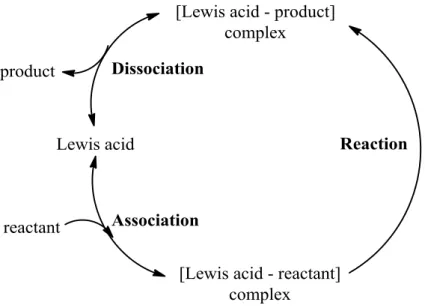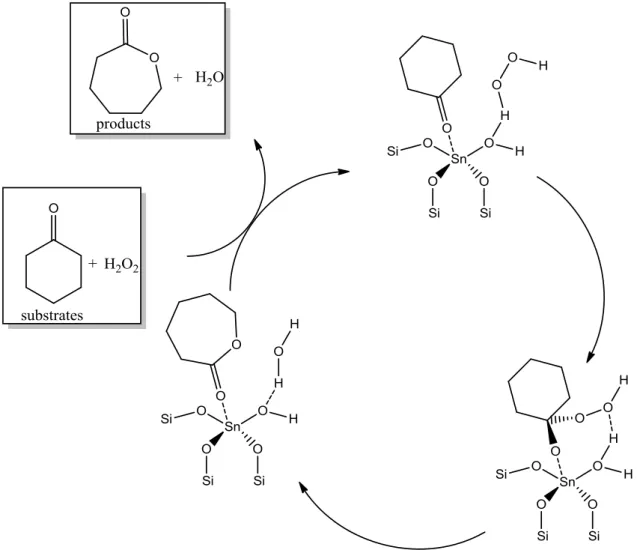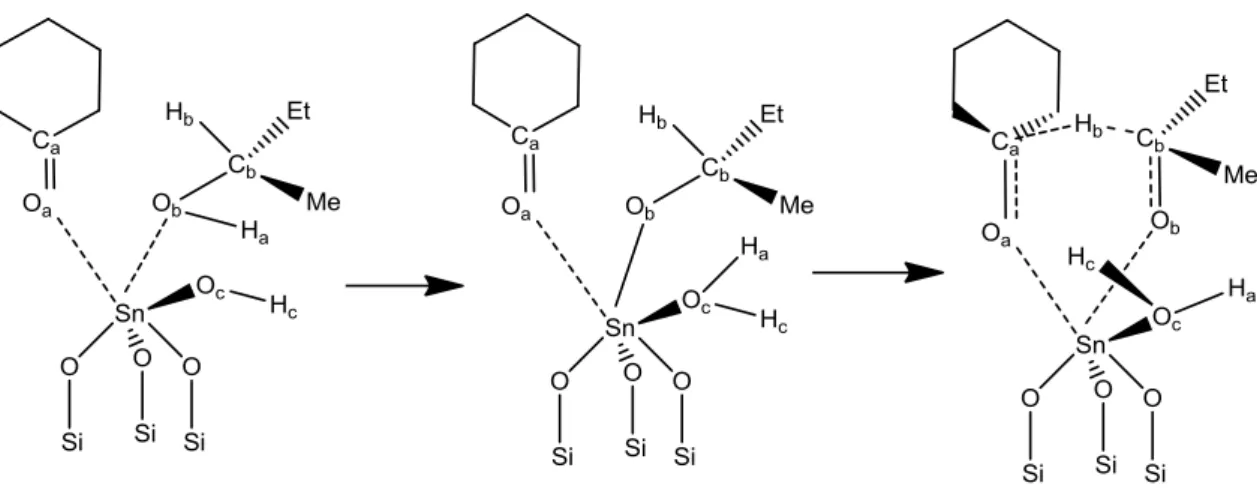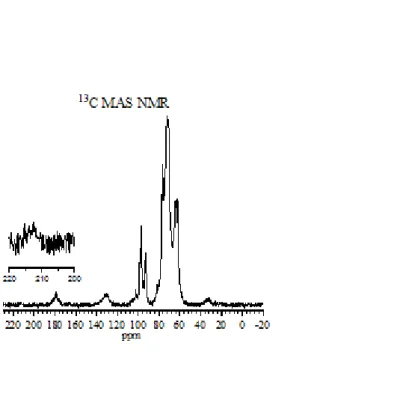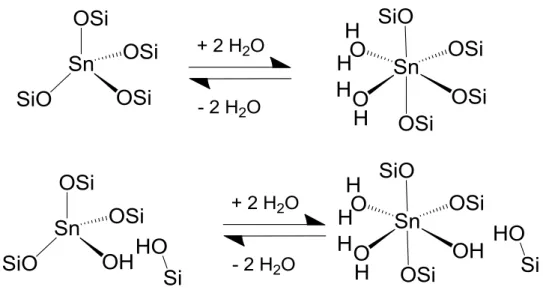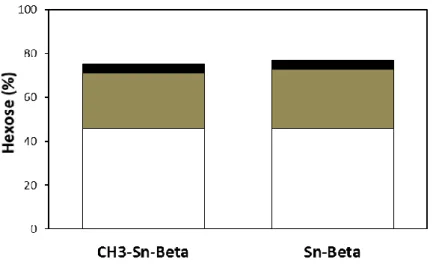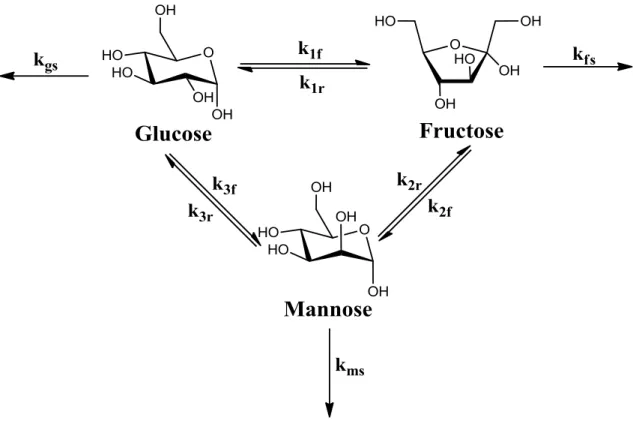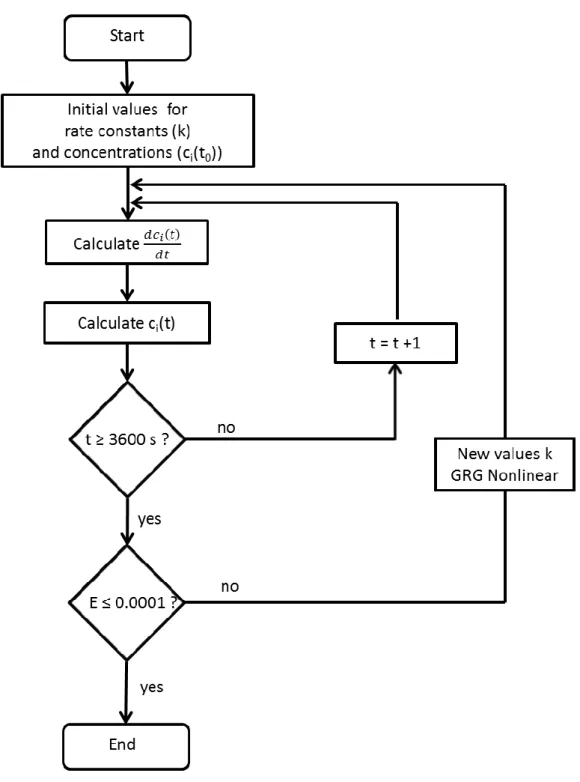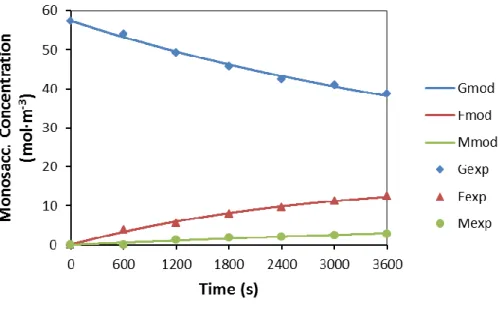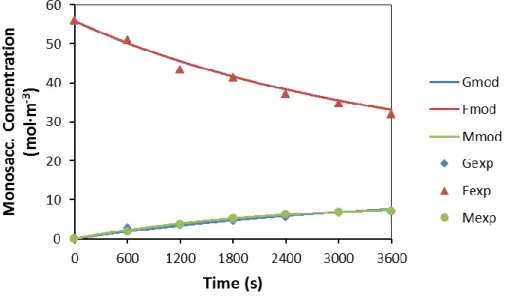I appreciate everyone in the Davis group for their help in the lab over these years. Special thanks to Yasho for help with lab startup, to Bingjun and Raj for scientific advice, and to Marat for helpful conversation. In addition, I would like to express my gratitude to the folks at Chevron R&D in Richmond for allowing me to intern with them during July-October 2012, especially C.Y.
I would like to thank all my classmates, professors and mentors in my home city of Valencia, Spain, who believed and trusted in me to pursue a PhD at Caltech. Last but not least, I would like to express my deepest gratitude to my family who have always supported and believed in my goals. The isomerization of glucose into fructose is a large-scale reaction for the production of high-fructose corn syrup, and is now considered an intermediate step in the possible route of biomass conversion into fuels and chemicals.
Specifically, glucose dissociates in the molecular sieve into the pyranose form, ring opens to the acyclic form in the presence of the Lewis acid center (framework Sn4+), isomerizes to the acyclic form of fructose, and ring closes to give the furanose product. Thus, skeletal sites with a proximal silanol group are the active sites for the 1,2 intramolecular hydride shift in the isomerization of glucose to fructose, while those sites with Na-exchanged silanol group are the active sites for the 1,2 intramolecular carbon. shift in epimerization of glucose to mannose.
Introduction and Thesis Organization
Biomass Conversion into Biofuels and Fine Chemicals
- Biomass Components
- Biomass Hydrolysis
- Biomass Applications
Introduction to Zeolites, Lewis Acids and Zeolite Sn-Beta
- Introduction to Zeolites and Molecular Sieves
- Lewis Acids
- Microporous and Mesoporous Lewis Acids
- Zeolite Sn-Beta
Motivation and Thesis Organization
The Glucose Isomerization into Fructose Reaction Pathway wih Sn-Beta
- Introduction
- Results and Discussion
- The Ring Opening
- Isomerization Step
- Reaction Centers with Sn or Ti Containing Zeolite
- The Formation of Mannose
- Conclusion
- Experimental and Additional Figures
- Synthesis of Ti-Beta, TS-1, Sn-Beta and CH 3 -Sn-Beta
- Isomerization Reactions
- Glucose Adsorption Experiments
- Characterization
- Additional Figures
- Computational Studies
- References
158 Figure 5.4 Distribution of monosaccharides and carboxylic acids from a 1% (w/w) glucose solution in water with Sn-Beta at 100ºC with glucose to tin ratio of 30. 160 Figure 5.6 Monosaccharides and carboxylic acids distribution from ' n 1% wt) glucose solution in methanol with Sn-Beta at 100ºC with glucose to tin ratio of 30. 161 Figure 5.7 Monosaccharides and carboxylic acids distribution from a 1% (wt/wt) glucose solution in methanol with Sn- Beta at 120ºC with glucose tin ratio of 30.
167 Figure 5.14 13C NMR spectra of (a) methyl fructose, (b) mixture of products using 13C1-glucose with SnO2/Si-Beta in methanol, (c) mixture of products using 13C1-glucose with Sn-Beta in methanol, (d ) mixture of products using 13C1-glucose with Sn-Beta in water, (e) methyl fructose, (f) mixture of products using 13C2-fructose with SnO2/Si-Beta in methanol, (g) mixture of products using 13C2-fructose with Sn-Beta in methanol and (h) a mixture of the product using 13C2-fructose with Sn-Beta in water. 168 Figure 5.15 13C NMR spectra of (a) dihydroxyacetone, (b) mixture of products using 13C1-glucose with SnO2/Si-Beta in methanol, (c) mixture of products using 13C1-glucose with Sn-Beta in methanol, (d) product mixture using 13C1-glucose with Sn-Beta in water, (e) dihydroxyacetone, (f) product mixture using 13C2-fructose with SnO2/Si-Beta in methanol, (g) product mixture using 13C2-fructose with Sn -Beta in methanol and (h) product mixture using 13C2-fructose with Sn-Beta in water. 169 Figure 5.16 13C NMR spectra of (a) glyceraldehyde, (b) mixture of products using 13C1-glucose with SnO2/Si-Beta in methanol, (c) mixture of products using 13C1-glucose with Sn-Beta in methanol, (d) product mixture using 13C1-glucose with Sn-Beta in water, (e) glyceraldehyde, (f) product mixture using 13C2-fructose with SnO2/Si-Beta in methanol, (g) product mixture using 13C2-fructose with Sn -Beta in methanol and (h) product mixture using 13C2-fructose with Sn-Beta in water.
170 Figure 5.17 13C NMR spectra of (a) pyruvaldehyde, (b) mixture of products using 13C1-glucose with SnO2/Si-Beta in methanol, (c) mixture of products using 13C1-glucose with Sn-Beta in methanol, (d) product mixture using 13C1-glucose with Sn-Beta in water, (e) pyruvaldehyde, (f) product mixture using 13C2-fructose with SnO2/Si-Beta in methanol, (g) product mixture using 13C2-fructose with Sn -Beta in methanol and (h) product mixture using 13C2-fructose with Sn-Beta in water. 176 Figure 5.23 13C NMR spectra of (a) HMF, (b) mixture of products using 13C1-glucose with SnO2/Si-Beta in methanol, (c) mixture of products using 13C1-glucose with Sn-Beta in methanol, (d) product mixture using 13C1-glucose with Sn-Beta in water, (e) HMF, (f) product mixture using 13C2-fructose with SnO2/Si-Beta in methanol, (g) product mixture using 13C2-fructose with Sn -Beta in methanol and (h) product mixture using 13C2-fructose with Sn-Beta in water.
The Glucose Isomerization into Fructose Mechanism with SnO 2 /Si-Beta
Site and Structural Characterization of Sn-Containing Samples
Glucose Conversion on Sn-Beta and SnO 2 -Containing Samples in Water
Glucose Conversion on SnO 2 -Containing Samples in Methanol
Glucose Conversion on Sn-Beta in Methanol
Experimental Procedure and Additional Figures
- Synthesis of Si-Beta, Sn-Beta, SnO 2 /Si-Beta and SnO 2 -SiO 2
- Characterization Methods
- N 2 Adsorption Isotherms and DRUV
Active Sites in Sn-Beta for Glucose Isomerization to Fructose and
- Summary of Microporous Materials
- Characterization of Microporous Materials
- Structural Characterization of the Sn Sites in Sn-Beta
- Mannose Formation with Na containing Sn-Beta
- Sodium Removal from Sn-Beta
- Glucose Isomerization and Epimerization Mechanisms
- Synthesis of Sn-Beta, 119 Sn-Beta, Na-Sn-Beta and Si-Beta
- Na + and H + Ion Exchange of Zeolite Samples
- Ammonia Adsorption onto Sn-Beta
- Argon Adsorption
- Scanning Electron Microscopy and X-ray Diffraction Characterization Methods
- Infra-Red Spectroscopy
- Reaction Procedures
- Glucose Conversion and Fructose and Mannose Yields
113 Figure 4.7 Schematic representation of the NH3 dosed Sn-Beta sample history explaining its characterization behavior. 144 Figure 4.28 Extended chemical shift region in the -400 to -480 ppm region of 119Sn MAS Solid State NMR spectra for 119Sn-Beta after various treatments: (a) dehydration after calcination, (b) dehydration after three Na exchanges and (c) ) dehydration after NH3.
Glucose Conversion into Carboxylic Acids with Sn-Bea and SnO 2 /Si-Beta
Glucose Conversion and Product Distribution
Sn-Beta exhibits a higher glucose conversion, indicating the higher Lewis acidity of the isolated Sn sites in the skeleton. Gorte et al.20 have shown with adsorbed deuterated acetonitrile in the IR how Sn-Beta. In the case of Sn-Beta in methanol, full glucose conversion was reached after two hours and one hour, respectively, indicating the high reactivity of the isolated tin centers in a non-aqueous solvent.
This would suggest that some of the Lewis acid sites in Sn-Beta are not completely hydrophobic, susceptible to attack by water and subsequent deactivation. As discussed in Chapter 2, mannose would rather isomerize to fructose than epimerize to glucose with Sn-Beta. The formation of carboxylic acids by Sn-Beta in water was observed at both 100 °C and 120 °C (Figure 5.4 and Figure 5.5 respectively), being higher for lactic acid (LA) than for vinyl glycolic acid (VGA).
However, since we are not at equilibrium, the formation of lactic acid appears to be governed by kinetics. With Sn-Beta, the solvent was changed to methanol, leading to higher glucose conversions and carboxylic acid yields. The product distribution was approximately the same after 240 min, suggesting the deactivation of the Lewis acid sites in Sn-Beta or the deposition of different organic products in the zeolite pores blocking the intra-diffusion of the molecules.
However, the yields of the products were quite low since the groups are not as active as the isolated sites of the Sn framework in Sn-Beta, as can be seen in Figure 5.8 and Figure 5.9. In methanol SnO2/Si-Beta was much more active in the isomerization of glucose and retro-aldol reactions. This was reflected in higher glucose conversions, reaching 57% and 79% at 100ºC and 120ºC, respectively, after 480 minutes.
The formation of carboxylates from a 1% (w/w) glucose solution in methanol confirms that SnO2/Si-Beta is also active in the retro-aldol reaction of both glucose and fructose. When these results are compared to Sn-Beta in water, the product distribution appears quite similar at equal glucose conversion. With Sn-Beta in water, at a glucose conversion of 74%, 6% and 2% yields of lactic acid and vinyl glycolic acid, respectively, were obtained after 60 minutes at 120°C, with a carbon balance of 71%.
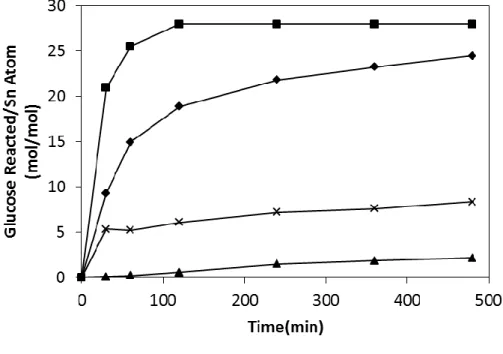
Carboxylate Formation Mechanism
Reaction conditions: 1% (wt/wt) monosaccharide with a monosacc/Sn ratio of 30 and 15 for Sn-Beta and SnO2/Si-Beta, respectively. In Figure 5.14, the presence of methyl fructose can be observed, formed with SnO2/Si-Beta and Sn-Beta in methanol as a solvent. In the case of Sn-Beta in water, fructose was not methylated due to the absence of methanol.
13C2-fructose with Sn-Beta in methanol and (h) product mixture with 13C2-fructose with Sn-Beta in water. These results were obtained by the same authors who calculated the glucose isomerization in fructose with the open site of Sn-Beta and one silanol group, which was 22.1 kcal/mol. All product mixtures were obtained from the following reaction conditions: 1% (wt/wt) monosaccharide with a monosac/Sn ratio of 30 and 15 for Sn-Beta and SnO2/Si-Beta, respectively.
Pyruvaldehyde was present in solution with SnO2/Si-Beta and Sn-Beta in methanol, and Sn-Beta in water as can be seen in the 13C NMR spectra of Figure 5.17. The intensities of the resonance bands of pyruvaldehyde in Figure 5.17 appear lower than the resonance bands of glyceraldehyde. The 13C NMR spectra show the methyl group ( = 19.1 ppm) of lactic acid and methyl lactate from the starting 13C1- glucose solution.
From the earlier 13C NMR spectra, we can conclude that the two carbon atoms of the starting glucose backbone stay together along the reaction pathway leading to the synthesis of lactic acid with Sn-Beta and SnO2/Si-Beta, as shown in figure 5.19. Unlike the synthesis of lactic acid with Sn-Beta and SnO2/Si-Beta, two different vinyl glycolic acid molecules are present in solution with both Sn-Beta and SnO2/Si-Beta catalysts, as shown in Figure 5.20 and Figure 5.21 . The 13C1 glucose solution resulted in the different labeling of two vinyl glycolic acid molecules in water or methyl vinyl glycolate molecules in methanol, with the isotopic labeling in methylene (ppm, Figure 5.20) and in the carboxylate.
All product mixtures were obtained from the following reaction conditions: 1% (w/w) monosaccharide with a monosacc/Sn ratio of 30 and 15 for Sn-Beta and SnO2/Si-Beta, respectively. The detection of erythrose and 2-oxobut-3-enal (Figure 5.1) could help substantiate the mechanistic pathway leading to the formation of vinylglycolic acid, but its low abundance made it difficult to identify the intermediates in 13C NMR. On the other hand, redistribution in the oxidation states of erythrose could also move the aldehyde to the carbon atom at the opposite end of the carbon skeleton (Figure 5.22) and consequently form vinylglycolic acid.
Experimental Procedure
- Synthesis of Sn-Beta and SnO 2 /Si-Beta
- Reaction Conditions
Summary and Future Direction
Conclusion
Future Work
- Sn-Beta Post-Treatment
- Calcination
